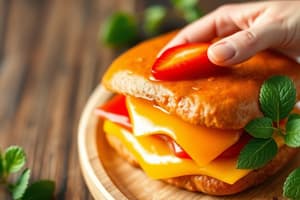Podcast
Questions and Answers
Besides reducing plastic waste, what specific environmental goal is Nestlé aiming to achieve by 2050?
Besides reducing plastic waste, what specific environmental goal is Nestlé aiming to achieve by 2050?
Nestlé aims to reach net-zero greenhouse gas emissions by 2050.
What event significantly boosted Nestlé's revenue in 1945, and what product fueled this increase?
What event significantly boosted Nestlé's revenue in 1945, and what product fueled this increase?
World War II significantly boosted revenue due to increased demand for condensed milk and coffee for soldiers.
Besides beverages and dairy, name two other significant product categories that contribute to Nestlé's revenue.
Besides beverages and dairy, name two other significant product categories that contribute to Nestlé's revenue.
Pet care and confectionery are also significant product categories.
What prompted Nestlé to focus on medical nutrition, leading to the creation of Nestlé Health Science in 2012?
What prompted Nestlé to focus on medical nutrition, leading to the creation of Nestlé Health Science in 2012?
How does Nestlé's global presence help the company to be more resilient against economic downturns?
How does Nestlé's global presence help the company to be more resilient against economic downturns?
In what specific area did Nestlé diversify its portfolio when it acquired L'Oréal shares in 1974?
In what specific area did Nestlé diversify its portfolio when it acquired L'Oréal shares in 1974?
What was the approximate revenue of Nestle in 1970? What acquisition contributed to this?
What was the approximate revenue of Nestle in 1970? What acquisition contributed to this?
Name three of Nestle's primary competitors.
Name three of Nestle's primary competitors.
What were Nestle's sustainability goals? Include dates.
What were Nestle's sustainability goals? Include dates.
When did Nestle enter the plant-based food sector and what brand did they do this under?
When did Nestle enter the plant-based food sector and what brand did they do this under?
What percentage of Nestle's revenue comes from the beverages product category? What are some of the included brands?
What percentage of Nestle's revenue comes from the beverages product category? What are some of the included brands?
What action did Henri Nestlé take to address malnutrition?
What action did Henri Nestlé take to address malnutrition?
When did Nestle Become a shareholder in L'Oréal? What industry did this help them expand into?
When did Nestle Become a shareholder in L'Oréal? What industry did this help them expand into?
What Nestle product became a global coffee brand?
What Nestle product became a global coffee brand?
What company did Nestle acquire that allowed them to enter the frozen pizza market?
What company did Nestle acquire that allowed them to enter the frozen pizza market?
What global trend is emphasized in Nestlé's current focus (2020s) regarding food production?
What global trend is emphasized in Nestlé's current focus (2020s) regarding food production?
Nestlé started with 1,000 employees in what year? By 2023, how many employees did they have?
Nestlé started with 1,000 employees in what year? By 2023, how many employees did they have?
Which region generates the most revenue for Nestlé as of 2023, and what percentage of the total revenue does it account for?
Which region generates the most revenue for Nestlé as of 2023, and what percentage of the total revenue does it account for?
Name three competing brands of Unilever?
Name three competing brands of Unilever?
Nestle had a peak revenue in 2010 of what billon CHF?
Nestle had a peak revenue in 2010 of what billon CHF?
Flashcards
What is Nestlé?
What is Nestlé?
A Swiss multinational food and beverage company founded in 1866 by Henri Nestlé.
What are Nestlé's focuses?
What are Nestlé's focuses?
Nutrition, health, and wellness with sustainable practices.
Expansion milestone (1875-1900)
Expansion milestone (1875-1900)
Nestlé expanded into new markets, including the USA, Latin America, and Australia
What is Nescafé?
What is Nescafé?
Signup and view all the flashcards
What is Maggi?
What is Maggi?
Signup and view all the flashcards
What market did Nestlé enter in 1984?
What market did Nestlé enter in 1984?
Signup and view all the flashcards
Who is Rowntree?
Who is Rowntree?
Signup and view all the flashcards
What market did Nestlé expand into in the 1990s?
What market did Nestlé expand into in the 1990s?
Signup and view all the flashcards
What is Néstle Health Science?
What is Néstle Health Science?
Signup and view all the flashcards
Where did Nestlé enter in 2017?
Where did Nestlé enter in 2017?
Signup and view all the flashcards
What is Unilever?
What is Unilever?
Signup and view all the flashcards
What does Nestle's product segment contribution chart present?
What does Nestle's product segment contribution chart present?
Signup and view all the flashcards
What is well-diversified?
What is well-diversified?
Signup and view all the flashcards
What is Nestle's statistical analysis?
What is Nestle's statistical analysis?
Signup and view all the flashcards
What is Nestle's Strategic Adaptability?
What is Nestle's Strategic Adaptability?
Signup and view all the flashcards
Revenue Growth
Revenue Growth
Signup and view all the flashcards
Workforce Growth
Workforce Growth
Signup and view all the flashcards
What contributes the most?
What contributes the most?
Signup and view all the flashcards
Study Notes
- Nestlé is a Swiss multinational food and beverage company
- The headquarters are in Vevey, Switzerland
- Henri Nestlé founded it in 1866
- It is one of the largest and most recognized food companies globally
- Nestlé operates in over 180 countries
- The company offers a wide range of products
- Products include dairy, confectionery, beverages, baby food, cereals, coffee, and pet food
- Key brands include Nescafé, KitKat, Maggi, Purina, and Nestlé Pure Life
- Nestlé focuses on nutrition, health, and wellness
- Aims to provide high-quality and sustainable products
- Nestlé is committed to reducing plastic waste
- The company is aiming to achieve net-zero greenhouse gas emissions by 2050
Early Years: Foundation & Growth (1866 – 1900)
- In 1866, Henri Nestlé, a Swiss pharmacist, founded Nestlé
- Nestlé created an infant cereal, “Farine Lactée,” to combat infant malnutrition
- By 1867, Nestlé's product gained popularity across Europe
- The Nestlé & Anglo-Swiss Condensed Milk Company was established in 1867
- Between 1875 and 1900, Nestlé expanded into new markets
- New markets included the USA, Latin America, and Australia
- Milk production factories were acquired
Expansion & Diversification (1900 – 1950)
- In 1905, Nestlé merged with the Anglo-Swiss Condensed Milk Company.
- The merger increased its dairy product range
- Nestlé acquired Peter-Cailler-Kohler in 1929
- Peter-Cailler-Kohler was one of the first Swiss chocolate manufacturers
- Nestlé entered the confectionery market
- In 1938, Nescafé was launched and became a global coffee brand
- During World War II (1939–1945), Nestlé expanded by supplying condensed milk and coffee to soldiers
Post-War Boom & Globalization (1950 – 1980)
- In 1947, Nestlé acquired Maggi, a leading brand in soups and seasonings
- During the 1960s – 1970s, Nestlé diversified into frozen foods
- The frozen food brands included Findus
- Diversified into mineral water (Perrier), and pet food (Purina)
- In 1974, Nestlé became a shareholder in L'Oréal, expanding into cosmetics
Innovation & Strategic Acquisitions (1980 – 2000)
- Nestlé entered the frozen pizza market with the acquisition of Stouffer’s in 1984
- In 1988, Nestlé acquired Rowntree
- It acquired the maker of KitKat, Smarties, and After Eight
- During the 1990s, Nestlé expanded into bottled water (Nestlé Pure Life) and pharmaceutical nutrition
Health, Wellness & Digital Transformation (2000 – Present)
- Roche’s nutrition division was acquired in 2001
- It strengthened its healthcare segment
- In 2012, Nestlé Health Science was created to focus on medical nutrition
- In 2017, Nestlé entered the plant-based food sector with Garden Gourmet
- During the 2020s, there was a focus on sustainability, digital transformation, and AI-driven food production
Nestlé's Primary Competitors
- Unilever is a British multinational consumer goods company
- Unilever sells food, beverages, cleaning agents, and personal care items
- Unilever's competing brands include:
- Ice Cream: Ben & Jerry's, Magnum
- Tea: Lipton
- Seasonings and Sauces: Knorr
- The Coca-Cola Company is an American multinational corporation
- It is known for its non-alcoholic beverages, primarily soft drinks
- Competing brands include:
- Bottled Water: Dasani
- Juices: Minute Maid
- Ready-to-Drink Teas and Coffees: Gold Peak, Honest Tea
- PepsiCo is an American multinational food, snack, and beverage corporation
- PepsiCo competes with Nestlé in various categories
- Competing brands include:
- Snacks: Lay's, Doritos
- Beverages: Pepsi, Gatorade
- Breakfast Cereals: Quaker Oats
- Danone is a French multinational food-products corporation
- Danone specializes in dairy and plant-based products, waters, early life nutrition, and medical nutrition
- Competing brands include:
- Dairy Products: Activia, Actimel
- Plant-Based Products: Alpro
- Bottled Water: Evian, Volvic
- Mondelez International is an American multinational confectionery, food, and beverage company
- Mondelez focuses on snack foods and beverages
- Competing Brands include:
- Chocolate: Cadbury
- Biscuits and Cookies: Oreo, Chips Ahoy!
- Gum and Candy: Trident, Halls
- Mars is an American multinational manufacturer
- Mars produces confectionery, pet food, and other food products
- Competing Brands:
- Chocolate: M&M's, Snickers
- Pet Food: Pedigree, Whiskas
- Rice: Uncle Ben's
- General Mills is an American multinational manufacturer and marketer
- It is known for branded consumer foods sold through retail stores
- Competing Brands:
- Breakfast Cereals: Cheerios, Wheaties
- Snacks: Nature Valley
- Yogurt: Yoplait
- Kraft Heinz is an American multinational food company
- Kraft Heinz is known for its condiments, sauces, and packaged foods
- Competing Brands:
- Sauces and Condiments: Heinz Ketchup, Kraft Dressings
- Cheese Products: Kraft Singles
- Ready-to-Eat Meals: Oscar Mayer
Revenue Growth Over Time (1866 - Present)
- Nestlé started as a small infant food manufacturer
- The company has grown into a global food giant
- Key milestones in revenue growth:
- 1900: ~0.05 CHF Billion due to expansion in Europe and the U.S.
- 1945: ~0.5 CHF Billion due to WWII supply contracts increasing demand
- 1970: ~3.5 CHF Billion due to the acquisition of Maggi and major diversification
- 2000: ~81 CHF Billion due to expansion into health & nutrition, and pet food
- 2010: ~109 CHF Billion due to strong presence in emerging markets
- 2023: ~94.4 CHF Billion due to focus on sustainability & digital transformation
Profitability & Market Value
- Consistent growth in profitability is due to strategic acquisitions, product diversification, and global expansion
- Net Profit:
- 1990s: CHF 3-4 billion
- 2000s: CHF 9-11 billion
- 2010s: CHF 12-15 billion
- 2023: CHF 14.5 billion
- Market Capitalization:
- 2000: ~CHF 80 billion
- 2010: ~CHF 180 billion
- 2023: ~CHF 300 billion+
Geographic Revenue Distribution (2023)
- North America: 32%
- Europe: 29%
- Asia, Oceania & Africa: 21%
- Latin America: 18%
Product Segment Contribution (2023)
- Beverages (Nescafé, Nespresso, etc.): 27%
- Dairy & Nutrition: 19%
- Pet Care (Purina): 18%
- Confectionery (KitKat, Smarties, etc.): 13%
- Prepared Dishes & Cooking Aids (Maggi): 12%
- Water (Nestlé Pure Life): 11%
Workforce Growth & Sustainability
- Workforce Growth:
- 1900: ~1,000 employees
- 1950: ~10,000 employees
- 2000: ~250,000 employees
- 2023: ~270,000 employees
- Sustainability Goals:
- Carbon Neutral by 2050
- 100% Recyclable Packaging by 2025
- 50% Reduction in Water Usage (2030 Goal)
Revenue Growth Observations:
- In 1900, Nestlé’s revenue was barely 0.05 billion CHF
- By 1945, revenue had increased to 0.5 billion CHF
- The 1970s marked a sharp rise as Nestlé diversified into new markets
- In 2000, revenue had skyrocketed to 81 billion CHF amid expansion in the health and nutrition sector
- The peak revenue was around 2010 (109 billion CHF)
- The revenue slightly declined to 94.4 billion CHF in 2023.
Product Segment Contribution Observations
- Beverages (27%) contribute the most, with brands like Nescafé and Nespresso
- Dairy & Nutrition (19%) is the second-largest segment with brands like Cerelac and NAN
- Pet Care (18%) via Purina has become a strong revenue driver
- Confectionery (13%), like KitKat and Smarties, remains an important sector
- Prepared dishes & cooking aids (12%), such as Maggi continue to perform well
- Water (11%), including Nestlé Pure Life contributes
Studying That Suits You
Use AI to generate personalized quizzes and flashcards to suit your learning preferences.



